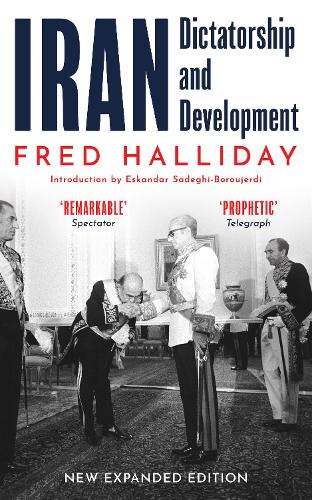
Iran: Dictatorship and Development
(Paperback)
Publishing Details
Iran: Dictatorship and Development
By (Author) Fred Halliday
Introduction by Eskandar Sadeghi-Boroujerdi
Oneworld Publications
Oneworld Academic
7th January 2025
United Kingdom
Classifications
Professional and Scholarly
Non Fiction
955.054
Physical Properties
Paperback
400
Width 135mm, Height 216mm, Spine 29mm
Description
It is quite possible that before too long the Iranian people will chase the Pahlavi dictator and his associates from power So wrote historian Fred Halliday in the conclusion to this prescient work on Iran in the twentieth century. Just months later the revolution of 1979 saw Shah Reza Pahlavi ousted and an Islamic theocracy established under Ayatollah Khomeini. Following a contextual study of the origins of the Iranian state, Halliday focuses on the period from the early 1960s to 1978, when protests swept the nation for the first time in fifteen years. Through an interdisciplinary approach, he assesses the economic, social and political conditions, taking in the nations uneven capitalist development, opposition movements and state repression, and the alliance between the Shah and the United States. Even three decades on, this classic study unique in its proximity to the revolution offers many insights into why and how the Shahs reign came to an end.
Reviews
Remarkable...almost miraculously timely...a carefully written, well-researched and deeply serious account of modern Iran.
* Spectator *Well-timed and prophetic...thoroughly researched.
* Telegraph *Much original analysis and relevant information not previously gathered together in any one book.
* Tribune *One of the most important scholars of his generation.
* Millennium: Journal of International Studies *Present[s] a rigorous and comprehensive analysis of Iranian society in the 1960s and 1970s Hallidays volume is a most welcome addition to the literature. Written on the very eve of the revolution in 1978 (except for an appended twelve-page Afterword dated March 1979), Iran: Dictatorship and Development is a significant contribution toward an understanding of the ancien rgime and also provides some insights into the causes of the revolution.
* Iranian Studies *Halliday provides us both with a framework for understanding [the revolution] in Iran, and an acute insight into the social forces in struggle. His array of sources is impressive, including not only secondary works but a wide and significant range of first-hand interviews and accounts.
* Race & Class *Published almost simultaneously with the climax of [the Iranian Revolution]the second edition includes the added bonus of an account of the rebellion and its aftermath. Hallidays book not only fills a gap in the serious literaturebut provides a valuable analysis of the nature of the Pahlavi state and the roots of its instability.
* Third World Quarterly *Author Bio
Fred Halliday was Professor Emeritus of International Relations at the London School of Economics and Research Professor at the Barcelona Institute for International Studies. A Middle East specialist, he authored many articles and books, including Islam and the Myth of Confrontation, The Middle East in International Relations and Two Hours that Shook the World.
